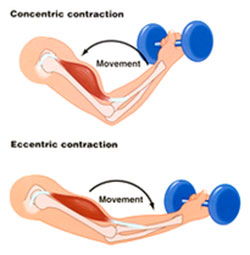Look at your upper arms as you flex (bend your arm at the elbow). You’ll see the top-of-the-arm muscle push up the skin (or “bulge” for those with python upper arms). What you’re observing is the contraction of your bicep. Contractions are the action that happened when muscles shorten. Lengthen or shortening of muscles are involved in most every movement we make.
In the case of contractions, there are two major types: isotonic and isometric. And you can tell the difference by what happens to the length of the muscle (shorten, lengthen, or no change).
Here’s a quick way to tell the difference of isotonic vs isometric contractions:
Contraction Type
Isotonic contraction: Muscle contractions are categorized by changes in the length of a muscle when it contracts. The roots of the word tell the story. “Iso” means “same” and tonic means “stretching”. Isotonic contractions are further broken down into two types of contractions: concentric and eccentric.
 * Concentric contraction: Muscle shortens and generates force. Example: The flexing of biceps. In this case the bicep muscle contracts (shortens) and causes the arm to bend at the elbow.
* Concentric contraction: Muscle shortens and generates force. Example: The flexing of biceps. In this case the bicep muscle contracts (shortens) and causes the arm to bend at the elbow.
* Eccentric contraction: Muscle elongates (lengthens) in response to a greater opposing force. Eccentric contractions slow down concentric contractions – serving as brakes. An example: The downward extension of the arm at the elbow when coming out of a bicep curl. That’s eccentric.
Most human activity and athletic performance involves movement, and that’s why isotonic exercise is useful and the most common in workout routines.
Isometric contraction: Force is generated without any change in the length of the muscle. It’s the opposite of Isotonic. Gripping something with your hand, like a water glass for example. When you grip, your finger/hand muscles contract (concentric) around the glass, but then to HOLD the grip as you pour water into the glass, no muscles are shortening or lengthen. They’re just “holding” the position of the grip as the glass gets heavier, which is the isometric part. The roots of the word tell the story. “Iso” means “same” and metric means “length”.
Many yoga poses are examples of isometric exercise. Once in the post, muscles “hold” joints in place.
So there you go, the shortening or lengthening of the muscle involved in a movement determines what type of isotonic contraction it is. If the muscle doesn’t move at all and just “holds in place”, it’s isometric.
Important in recovery
After a sporting event or intensive workout, your muscles are sore and fatigued. Sports massage therapists use their knowledge of contractions to help muscles feel better and recover more quickly. When a muscle in contracted through active engagement by the therapists, the bodywork can penetrate muscles more deeply, broadening concentrically contracted muscles and lengthening eccentrically contracted muscles. The result is a reduction in muscle soreness and less delayed onset muscle soreness (DOMS).










